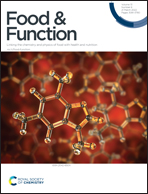Characterization of the structure, stability, and activity of hypoglycemic peptides from Moringa oleifera seed protein hydrolysates†
Abstract
Moringa oleifera seed protein hydrolysates exhibit good hypoglycemic activity, but their specific peptide components have not yet been characterized. Here, we identified the ultrafiltration peptide components (<3 kDa) of M. oleifera seed protein hydrolysates. A highly active α-glucosidase inhibitory peptide with an IC50 value of 109.65 μM (MoHpP-2) with the amino acid sequence KETTTIVR was identified. We characterized its structural properties, stability, and hypoglycemic activity. MoHpP-2 was found to be an amphipathic peptide with a β-turn structure, and the hemolysis of red blood cells was not observed when its concentration was lower than 2 mg mL−1. MoHpP-2 was stable under weakly acidic conditions, at temperatures lower than 60 °C, and at high ion concentrations. Western blotting revealed that MoHpP-2 affected the PI3K and AMPK pathways of HepG2 cells. Molecular docking revealed that MoHpP-2 interacted with α-glucosidase through hydrogen bonding and hydrophobic forces. Thus, MoHpP-2 from M. oleifera seeds could be used to make hypoglycemic functional foods.



 Please wait while we load your content...
Please wait while we load your content...